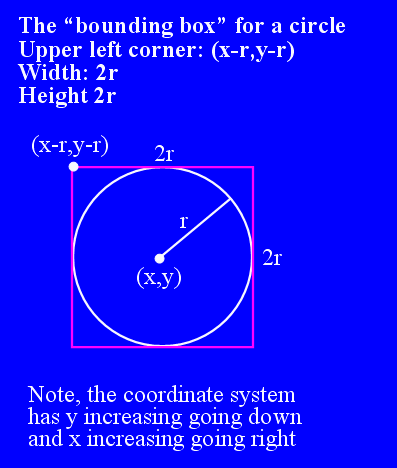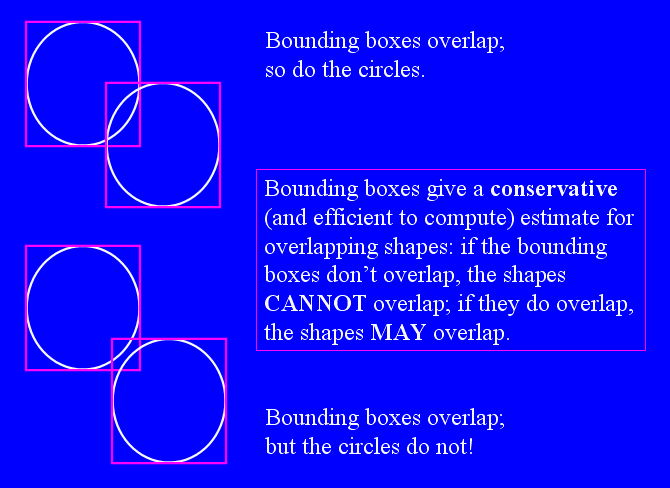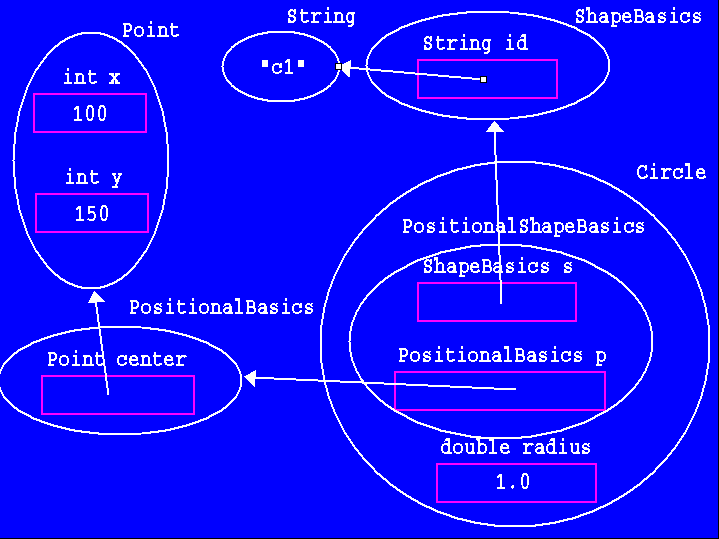
Here the root of the inheritance hierarchy is shown as the concrete Object class. The Shape subclass, defined exactly as shown above, extends this concrete superclass and introduces an abstract method (getArea), so it becomes abstract. The PositionalShape subclass, extends the abstract Shape superclass.
It defines a constructor that initializes one new instance variable, a Point (read its Javadoc in the standard Java library) that specifies the position of the center of the shape (an x,y coordinate) on a 2-dimensional plane. This class adds a few new methods that manipulate the position, and adds one additional abstract method that returns the bounding box of the shape (the smallest Rectangle in which the shape can be enclosed; note, this class has the full name java.awt.Rectange and IS NOT the Rectangle class that we will define; read its Javadoc in the standard Java library). Finally, it adds one additional method that detects whether two shapes "may overlap" by checking for intersection in their bounding boxes: if the bounding boxes don't intersect, there is no possibility of an overlap.
So, this class must be abstract because it contains two abstract methods:
it specifies getBoundingBox and also inherits (and doesn't override)
getArea.
Here is a complete the class.
public abstract class PositionalShape extends Shape {
public PositionalShape (String id, int centerX, int centerY)
{
super(id);
center = new Point(centerX,centerY);
}
//These abstract methods must be defined in a concrete subclass.
public abstract Rectangle getBoundingBox();
public Point getCenter ()
{return center;}
public double distanceTo (PositionalShape other)
{return center.distance(other.center);}
public void moveCenterTo (Point newCenter)
{
center.x = newCenter.x;
center.y = newCenter.y;
}
public void moveCenterBy (int dx, int dy)
{
center.x += dx;
center.y += dy;
}
public boolean mayOverlap (PositionalShape other)
{return getBoundingBox().intersects(other.getBoundingBox());}
public String toString ()
{return "PositionalShape[center="+center+","+super.toString()+"]";}
//Fields
private Point center;
}
Notice that although this class does not know how bounding boxes are constructed from PositionalShape objects (that method is abstract), it defines a concrete mayOverlap method because it knows that the getBoundingBox method in any concrete subclass of PositionalShape is defined concretely. Thus, just as the concrete toString method in the Shape class called the abstract method getArea, the concrete mayOverlap method in the PositionalShape class calls the abstract method getBoundingBox.
Finally, we can define the Circle subclass as follows.
Note that it is concrete: it extends the abstract PositionalShape
class, and overrides both the getArea and getBoundingBox
methods.
public class Circle extends PositionalShape {
public Circle (String name, int centerX, int centerY, double r)
{
super(name,centerX,centerY);
radius = r;
}
//Overide the abstract method declared in Shape
public double getArea()
{return Math.PI * radius * radius;}
//Overide the abstract method declared in PositionalShapee
public Rectangle getBoundingBox()
{
return new Rectangle( (int)(getCenter().x-radius),
(int)(getCenter().y-radius),
(int)(2*radius),
(int)(2*radius) );
}
public double getRadius()
{return radius;}
public void setRadius(double newRadius)
{radius = newRadius;}
public String toString( )
{return "Circle[radius="+radius+","+super.toString()+"]";}
//Fields
private double radius;
}
The bounding boxes are specified by the coordinate of the shapes upper-left
corner and its width and height.
For a circel, here is a picture of its bounding box.




